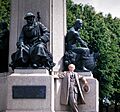Exeter War Memorial facts for kids
Quick facts for kids Exeter War Memorial |
|
|---|---|
| United Kingdom | |
 |
|
| For World War I World War II Korean War Falklands Conflict Northern Ireland Afghan conflict | |
| Unveiled | 1923 |
| Location | 50°43′35″N 3°31′54″W / 50.726339°N 3.531623°W |
| Designed by | John Angel (sculptor) |
| Commemorated | |
The Exeter War Memorial, also known as The Northernhay War Memorial, is a special monument in Northernhay Gardens in the city of Exeter, Devon. It was designed by a sculptor named John Angel. People donated money to build it, and it cost more than £6,000. The memorial was finished and shown to the public in 1923.
Contents
History of the Memorial
Designing the Monument
John Angel was a talented sculptor. When he designed this memorial, he was working with another famous artist, Sir George Frampton. You can see Sir George's influence in the memorial's style. The main figure on the memorial, called "Peace" or "Victory," was even shown at The Royal Academy in 1922.
What the Memorial Looks Like
The memorial is made from stone from Blackingstone Quarry, near Moretonhampstead. It was built by Easton & Son of Exeter. The whole monument stands about 9.4 meters (31 feet) tall. Its base, called a pedestal, is about 6.1 meters (20 feet) high.
The most important part is the figure at the very top, which is about 2.4 meters (8 feet) tall. This figure represents "Victory." She holds a branch of laurels, which is a symbol of thanks and honor. She stands on a dragon, showing triumph over challenges.
Around the base of the memorial, there are four bronze figures. Each one represents a different part of the war experience:
- A soldier
- A sailor on a ship
- A prisoner of war
- A V.A.D. nurse holding a bandage
If these figures were standing, they would each be about 2.2 meters (7 feet 4 inches) tall.
The Dedication Ceremony
The Exeter War Memorial was officially opened in 1923. The ceremony was led by the Bishop of Crediton, Robert Trefusis. A very important person, Admiral David Beatty, unveiled the memorial. The ceremony ended with a trumpeter playing "The Last Post" from Athelstan's Tower.
Protecting the Memorial During War
During World War II, a tall brick wall was built around the memorial. This was done to protect it from possible bomb damage. Only the figure at the top could be seen. After the war, new bronze plaques were added to the base. These plaques honored soldiers who died in World War II.
Exeter's Two Memorials
The Exeter War Memorial is one of two main war memorials in the city. The other is the Devon County War Memorial. It was designed by Sir Edwin Lutyens and is a simple cross outside Exeter Cathedral. These two memorials were planned by different groups.
Recent Events at the Memorial
Remembering Harry Patch
In November 2010, a special ceremony was held at the memorial. This was after the death of Harry Patch. He was the last English soldier who survived World War I trench warfare. Dr. Todd Gray, a historian from Devon, said that Harry Patch's death reminded everyone that it was time to truly remember. He encouraged people to visit the memorial and show their respect.
Honoring Recent Fallen Soldiers
On September 10, 2012, a new memorial was dedicated. This new monument honors people from Exeter who have died in conflicts since World War II. It is meant to go along with the original 1923 memorial. Air Chief Marshal Sir Stuart Peach hosted the dedication.
This new memorial honors ten servicemen from Exeter. They lost their lives in places like Afghanistan, Iraq, and Northern Ireland. The families of these soldiers helped decide what the memorial should look like.
Many important people attended the dedication. These included the Lord Mayor Councillor Rob Newby and the Bishop of Exeter the Rt. Rev. Michael Langrish. Mayor Newby said that the city already honors those from the two Great Wars. He felt it was important to also honor those who have died since 1945. The new memorial is a polished granite stone with an important message and the ten names. The Exeter City Council asked for it to be built. It is now a place for local services on Remembrance Sunday. Like the first dedication, this ceremony also ended with "The Last Post."
Historic Building Status
In September 2014, Historic England gave the original memorial a special status. It was named a Grade II* listed building. This means it is a very important historic building that needs to be protected.
Images for kids








